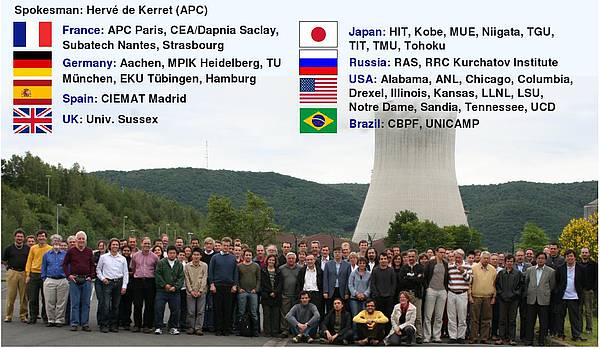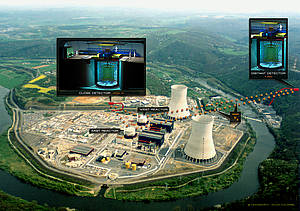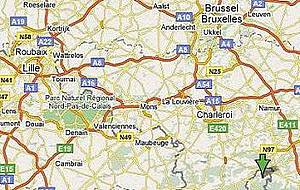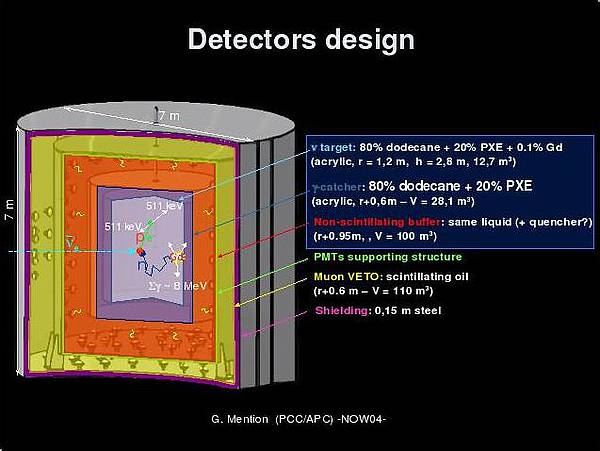
In the French Ardennes scientists from France, Germany, Spain, Russia, Japan, UK, Brasil and the USA are operating the Double Chooz project, an experiment, which shall complete our knowledge about neutrino oscillations and the fundamental properties of these elementary particles. Therefore, a nuclear power plant serves as neutrino source with a huge flux, being monitored by two equal detectors in different distances to the two reactor blocks.
 |
 |
DOUBLE CHOOZ: OSCILLATIONS OF REACTOR NEUTRINOS
In the recent years neutrino experiments made great strides. Nowadays it is confirmed that neutrinos possess rest mass and that there are (at least) three different neutrino flavours. It is of great importance that neutrinos can change their flavour. As this happens periodically during the propagation of the particle one speaks of neutrino oscillations. For this process two values are important: The differences between the squares of the neutrino masses and the mixing angles. In the case of three flavours there are three mixing angles (and one phase causing CP-violation). The mass square differences determine the frequency of the oscillations, while the mixing angles contain the maximum conversion probability from one flavour to the other and, therefore, give the amplitude of the oscillation. Double Chooz shall continue the search for the third still unknown mixing angle θ13 and by this allow the complete description of the neutrino oscillations between the three flavours.
 |
DETECTION OF REACTOR NEUTRINOS
In order to measure the mixing angles very precisely one needs to have an intense neutrino source. In the case of Double Chooz the nuclear power plant in Chooz (France) with two reactor cores was chosen. In the reactor core radioactive elements decay and in doing so emit electron antineutrinos, typically more than 1020 per core and second. Due to their weak interaction these particles have huge attenuation lengths (they travel e.g. 30 lightyears in water before the first interaction takes place). Only due to the great number of antineutrinos from the reactor there is a possibility to detect them in a sensitive detection system. For that reason, the first successful detection of neutrinos took place at a reactor site in the USA in 1956 by Cowan and Reines.
Up to now, the neutrino experiments with reactor antineutrinos were limited in their results, because the total neutrino flux was only known with great uncertainties, as well as the detection efficiencies. The most precise experiment till now was located in Chooz, too. In a distance of one kilometre to the two reactor cores a subterranean laboratory containing a neutrino detector was operated between 1995 and 1998. But the antineutrino flux from the reactors had to be calculated from the thermal power - with great uncertainties!
The concept of Double Chooz is to make a competitive measurement with two identical detectors. One detector, meant to measure the total neutrino flux from the nuclear power plant without oscillations precisely, is located in an average distance of 400 metres from the two reactor cores. The second detector has a distance of about one kilometre to the power plant. Here the scientists expect (for a not too small mixing angle θ13) effects from the disappearance of the electron antineutrinos.
The lenght scale of this effect is determined by the neutrino oscillations, which can be recognized by comparing the total flux and the shape of the neutrino spectrum in both detectors. Taking this together with the known distances of the detectors from the reactor cores one can calculate the mixing angle θ13, or, if no effect can be seen within the precision of the measurement, an improved upper limit can be given.
 |
DETECTION METHOD
In order to detect the electron antineutrinos from the reactor the so-called "inverse β-decay" is used: a proton captures an electron antineutrino and is converted into an neutron and a positron. The signal of a neutron in coincidence with the signal from a positron in the detector gives the signature of one of the very seldom neutrino events. Per detector around 8 tons of a liquid scintillator in a tank made of transparent acrylics serve as target. The positron as well as the neutron produce a short flash of light, detected by 390 10'' photomultiplier tubes, where the signal from the neutron is delayed in comparison to the that from the positron. This short time delay is meant to be a secure proof for a neutrino capture event. For this detection method a very efficient neutron detection is the crucial point. It is based on the very high neutron capture cross-section of the element Gadolinium, dissolved in the liquid scintillator in the innermost part of the detectors. The neutron capture at Gd is followed by a 8 MeV photon, which can be detected. The delayed coincidence of the positron and the neutron signal is used to distinguish between true neutrino signals and unwanted background events.
Both detectors are moreover built up subterranean in order to shield them against cosmic rays. The far detector site is built up in an already existing laboratory covered by roughly 100 metres of rock, while the underground laboratory for the near detector has still to be built up. In spite of this shielding espacially muons from the cosmic rays cannot be stopped. That is the reason why the detectors will be surrounded by muon vetos in order to be able to distinguish between muon induced signals and neutrino events.
RECENTLY RELEASED DATA
Up to now the best numerical value for θ13, reached in the Chooz experiment, was sin2(2θ13) < 0.15. In April 2011, Double Chooz started data taking with the far detector only. However, already within this first phase indications for non-zero value of θ13 could be found. In December 2011, the best fit value sin2(2θ13) = 0.086 ± 0.041 (stat) ± 0.030 (syst), or, at 90% C.L. 0.015 < sin2(2θ13) < 0.16 could be released. Nevertheless, data taking needs to go in order to further improve this result and diminish its errors, leading to an experimental evidence for a non-vanishing third mixing angle.
OUTLOOK
The building-up of the near detector is ongoing and shall be finished in 2013. From that time on Double Chooz will be able to search for the third mixing angle θ13 with unrivaled sensitivity. The potential of future neutrino experiments with accelerators observing a neutrino beam over a baseline, which is hundreds of kilometres long, depends particularly on the exact value of θ13.
There is great interest in the complete knowlegde of the mechanism of neutrino oscillations between all three flavours. The total exploration of the fundamental properties of these elementary particles is also useful for answering the question, whether neutrinos are responsible for the excess of matter over antimatter in the universe or not.
This work has been supported by the funds of the Deutsche Forschungsgesellschaft DFG (Transregio 27: Neutrinos and beyond) and the Exzellenzcluster "Origin and Structure of the Universe: The Cluster of Excellence for Fundamental Physics".
PUBLICATIONS
- DoubleChooz Collaboration,
"Indication for the disappearance of reactor electron antineutrinos in the Double Chooz experiment", arXiv:1112.6353 [hep-ex]
- DoubleChooz Collaboration,
"Letter of Intent for Double-CHOOZ: a Search for the Mixing Angle Theta13", hep-ex/0405032
- S. Berridge et al.,
"Proposal for U.S. participation in Double-CHOOZ: A New theta-13 Experiment at the Chooz Reactor", hep-ex/0410081
- K. Anderson et al.,
"White Paper on Measuring Theta13 with a reactor experiment"
- F. Ardellier et al.,
"Proposal: Double Chooz, a Search for the neutrino mixing angle θ13", hep-ex/0606025
- M. Hofmann
"Detection of Electron-Antineutrinos in Liquid Scintillators via the Inverse Beta Decay - Event Signatures and Possible Backgrounds", Poster at the 522th WE Heraeus Seminar in Bad Honnef, 20.1.2013 - 23.1.2013
DIPLOMA AND PHD THESES AT E15
- Michael Franke,
- Nils Haag,
"Bestimmung des Antineutrinospektrums von U-238",
Diploma thesis, Technische Universität München, July 2008
"Experimental Determination of the Antineutrino Spectrum of the Fission Products of U-238", PhD thesis, Technische Universität München, 2013
- Martin Hofmann,
"Low-Background Gamma Spectroscopy for the Neutrino Oscillation Experiment Double-CHOOZ",
Diploma thesis, Technische Universität München, November 2007
"Liquid Scintillators and Liquefied Rare Gases for Particle Detectors - Background-Determination in Double Chooz and Scintillation Properties of Liquid Argon", PhD thesis, Technische Universität München, December 2012
- Judith Sarah Meyer,
"Realization and Characterization of the Muon Veto Scintillator and the Buffer Liquid of the Double Chooz Experiment", Diploma thesis, Technische Universität München, December 2010
- Patrick Pfahler,
"Bestimmung der absoluten Lichtausbeute des Flüssigszintillators für die äußeren Detektorkomponenten des Neutrinoexperiments Double Chooz", Diploma thesis, Technische Universität München, January 2007
- Anton Röckl,
- Vincenz Zimmer,
"Development of a muon track reconstruction with the inner veto of Double Chooz",
Diploma thesis, Technische Universität München, November 2010
LINKS
MEMBERS OF THE DOUBLE CHOOZ GROUP AT E15
- Simon Appel
CONTACT
If you are interested in a diploma or PhD thesis on this topic, please contact Prof. Dr. Lothar Oberauer.
Page last edited on 14th of January 2012 by Martin Hofmann.

